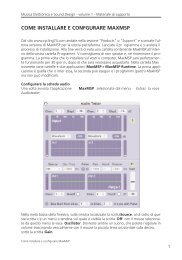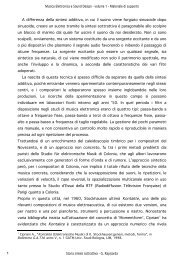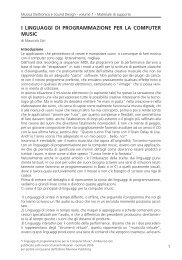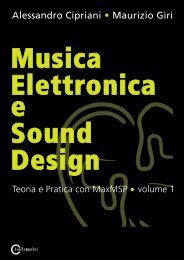programming with max/msp - Virtual Sound
programming with max/msp - Virtual Sound
programming with max/msp - Virtual Sound
Create successful ePaper yourself
Turn your PDF publications into a flip-book with our unique Google optimized e-Paper software.
LEARNING AGENDA 4T<br />
PREREQUISITES FOR THE CHAPTER<br />
• Contents of Chapters 1, 2, and 3 (theory)<br />
LEARNING OBJECTIVES<br />
Knowledge<br />
• to learn about the theory and praCtiCe of low frequenCy osCillators<br />
• to learn about the use of dC offset <strong>with</strong> lfos<br />
• to learn about the use of frequenCy modulation for vibrato<br />
• to learn about the use of amplitude modulation for tremolo<br />
• to learn about the use of pulse-width modulation<br />
• to learn how to use lfos to Control filters<br />
• to learn about the use of pseudo-random signal generators for Control<br />
• to learn how to use lfos to Control loCation in stereo and multi-Channel systems<br />
SKillS<br />
• to be able to hear and desCribe lfo-Controlled modulations of basiC parameters<br />
CONTENTS<br />
• low frequenCy osCillators: depth, rate, and delay<br />
• managing lfo parameters and using dC offset<br />
• managing vibrato, tremolo, and pwm using lfos<br />
• managing filter parameters using lfos<br />
• positioning and moving sound in stereo and multi-Channel systems<br />
• modulating Control osCillators <strong>with</strong> pseudo-random lfos<br />
ACTiViTieS<br />
• interaCtive examples<br />
TESTING<br />
• questions <strong>with</strong> short answers<br />
• listening and analysis<br />
SUPPORTING MATERIALS<br />
• fundamental ConCepts<br />
• glossary<br />
from “Electronic Music and <strong>Sound</strong> Design” Vol. 1 by Alessandro Cipriani and Maurizio Giri<br />
© ConTempoNet 2010 - All rights reserved







